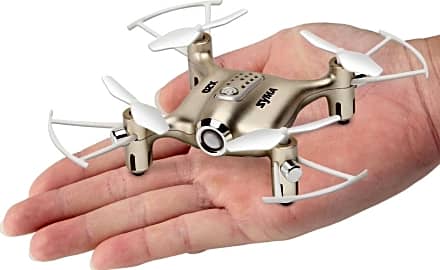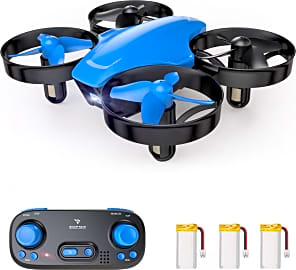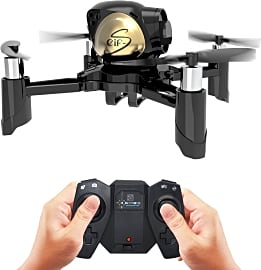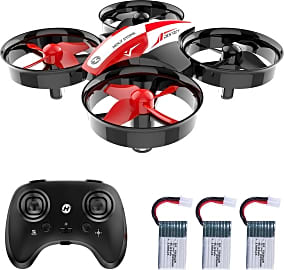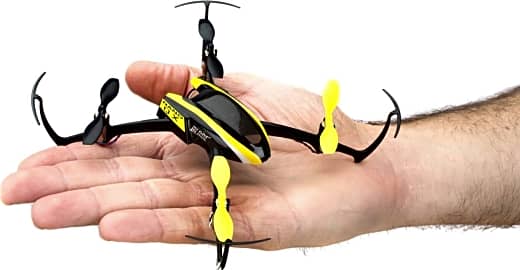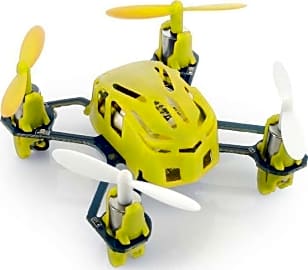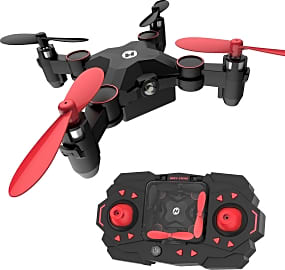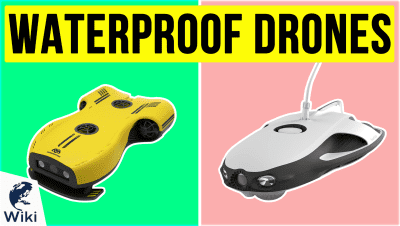The 10 Best Nano Drones

This wiki has been updated 45 times since it was first published in September of 2015. Tiny enough to take off from the smallest of launchpads, these nano drones may not have cameras or ultra-long battery lives, but they can deliver tons of remote-controlled flying fun. Try one of these diminutive machines if you're new to piloting, have limited airspace to work with, or need to reduce the collateral damage of occasional (or all-too-frequent) crash landings. When users buy our independently chosen editorial picks, we may earn commissions to help fund the Wiki.
Editor's Notes
January 26, 2021:
Unlike with full sized drones, there aren't a lot of breakthrough features added to nano models from year to year. This means that we aren't constantly seeing longer and longer flight times or better and better video recording capabilities. Instead, these are simply affordable little toys designed to entertain pilots for a short period of time. After researching the models available in the market, we didn't find any of particularly noteworthy interest that deserved to dethrone or current recommendations, and, as such, there were no changes needed to be made at this time.
January 10, 2020:
There's no solid consensus on exactly what constitutes a nano-class drone, but generally speaking, the smallest effective and readily available options get as small as 2-3 inches across, and their simplicity makes them ideal for beginners of all ages. Of course, their compact size means their battery life will be somewhat limited (because they just aren't strong enough to carry huge power sources), but some, such as the Snaptain SP300, Snaptain SP350, and Holy Stone HS210, come with multiple batteries that you can swap out to increase the time between charges. Furthermore, all three of those also have circular rotor guards that prevent damage in the case of collisions. And speaking of rotor protectors, the Syma X20, Blade QX, and Blade Inductrix have partial guards and are essentially highly miniaturized versions of full-size drones. The Blades are widely considered as some of the highest-quality options in the category, and the only reason the QX didn't place more highly on our list is the the controller included with the RTF version isn't very well regarded. So, we highlighted the BNF version, which is still a very good choice, although you will have to supply and pair your own remote.
The GiloBaby STEM is one of the few that requires assembly, but not only is that process not very difficult, it can be both fun and enlightening for budding engineers and pilots. And in a category filled with small devices, the Sky Viper Dash and Hubsan H111 both stand out as even more compact than many others. They lack most advanced features such as automatic stabilization and flight sensors, but their light weight actually helps provide a slightly longer flight time than larger options.
It's also important to note that due to their small size and relatively low power levels, most drones in this category lack cameras and are susceptible to the elements, but as long as you're careful, they should offer reasonably long lifespans.
Better Than The Average Drone
However, the FAA currently restricts drones being used to make money, so professional photographers will have to wait on that front.
Unlike your average drone for recreational use, nano drones are small enough to fit in the palm of your hand. They fly in a similar manner to other recreational drones, however, they are generally easier to operate and better for beginners. They are also a perfect choice for children who want to get into drone flying and parents who don’t want to spend a lot of money. The micro quadcopters are excellent for learning the basic drone-flying skills without worrying about causing significant damage to surrounding property or the drone itself.
While there are a wide range of nano drones on the market for recreational use, nano drones have been in development for use by the military and various entities for some time. The Black Hornet Nano was invented in Norway and is used by the Norwegian and British Armies.
Other nano drones include the Dragonfly Drone and the Hummingbird Drone. The Dragonfly Drone was used in 2007 at a protest in Washington D.C. It is a military surveillance drone that uses the physics of a dragonfly in order to hover and fly in all directions. The Hummingbird Drone is designed to look almost exactly like a hummingbird and flies in a similar manner. It is used by the military for surveillance as well. None of these three drones can be purchased by the general public.
However, the nano drones available for public use have a number of incredible capabilities and uses. Nano drones and their larger counterparts are poised to be the next big thing in photography with many of them being equipped with high-powered cameras. However, the FAA currently restricts drones being used to make money, so professional photographers will have to wait on that front.
Drone hobbyists are enjoying using nano drones and the large recreational drones for first-person view(FPV). These drones are equipped with a camera and beam a video to a pair of goggles.
One big advantage to nano drones is that if they are under nine ounces in weight, they don’t have to be registered with the FAA. Their small size and shorter flight times allow you to get the experience of flying a drone without putting a damper on your fun with government regulations.
Flight With A Purpose
You’re not going to break the bank buying a nano drone no matter what you choose, but there are a few things you should think about before you make your purchase.
First, are you buying for fun or practice? If you just want a cheap drone to fly for fun, nearly any nano drone will do. However, if you are a beginner and in need of practice before you move onto the more expensive models, you will want to pick one with all of the capabilities of the bigger drone you intend to buy.
Unfortunately, this means that they have short flight times.
Second, do you want to take photos and videos? If you are interested in recording your flights, you will need to purchase a nano drone with a camera. Because it is a nano drone, you will have low probability of damage in the event of a crash, and you can have all the advantages of a photo and video capable drone without the high price tag.
Third, consider the flight time. Nano drones have small batteries and generally charge quickly. Unfortunately, this means that they have short flight times. If you are purchasing a nano drone, you are likely looking at no more than ten minutes of maximum flight time on the best models.
Finally, consider whether you want to fly your drone indoors or outdoors. The mini quadcopters are generally best for outdoor flight because they offer more stability. If you plan to purchase a nano drone that is not a quadcopter, understand that it will likely not fly well in anything stronger than a light breeze. Regardless of the nano drone you choose, practice indoors before venturing outside.
A Brief History of the Nano Drone
The most advanced nano drones in existence today have been designed for military use by several different countries. However, the nano drones designed for recreational use have been patterned after the designs of their larger counterparts. They operate in a similar manner, and many of them share all of the same features as an average-sized drone. The biggest advantages to these nano drones are that they are more affordable, sustain less damage, and are not subject to FAA regulations as long as they weigh under nine ounces.
History tells us that the first drones were actually hot air balloons that were used to drop explosives on enemies during the American Civil War.
History tells us that the first drones were actually hot air balloons that were used to drop explosives on enemies during the American Civil War. Archibald M. Low created “Aerial Target” in 1916 as the first attempt at an actual unmanned aerial vehicle (UAV).
Germany and the Nazis began developing a UAV program during World War II and unleashed the formidable V-1 upon the world. This prompted the United States to begin its own UAV program to use for more than just pilot and combat training tools.
The best thing about UAVs is that they completely eliminate the need for an on-board pilot, but many of those used in the military have the same combat and surveillance capabilities as a manned aircraft.
Military nano drones such as the Black Hornet Nano and Hummingbird Nano are used to survey enemy territories and areas in which dangers might go otherwise unseen. They provide a significant tactical advantage and prevent a significant number of casualties.


